
Company-level training drills prepare your firefighters for battle. The battle includes saving lives, extinguishing fires, and bringing your entire crew back home safe and alive. The first half of this article talks about that preparation. The second half will give you five drills you’re not going to find in the books.
RELATED FIREFIGHTER TRAINING
- Q & A: Raul Angulo on Drills You Won’t Find in the Books
- Plastic Tubing Ax Scabbards
- Drills You Won’t Find in the Books: Bangor Ladder Rescue for H-Shaped Buildings
- Drills You Won’t Find in the Books: Stokes Snow Sled Drill
Most, if not all, of the drills for the firefighter are found in the Firefighter I and II curriculum. Once firefighters make it into the company, the department training calendar becomes bombarded with required and certified annual training. For example, this could include incident command system/incident management system training, hazmat, emergency medical services (EMS) recertifications, emergency vehicle accident prevention, confined space, safety, and an ever-increasing number of required subjects that fall under the heading of human resources (HR)—I am sure there are more. Add that on top of the mounting fire prevention inspections, regular station and apparatus maintenance, and the annual increase in call volume, and that’s it! The productive day is full. So, when do you find time to drill on the tasks you signed up for when you joined the fire department?
Returning to the Basics
We keep hearing a recurring theme about how we need to return to the basics. Why is that? Because most firefighters are not getting hurt or killed on EMS calls, confined space, or HR incidents. (They may be getting disciplined and fired on HR incidents, but not hurt or killed!) No, the close calls and line-of-duty deaths (LODDs) are happening on or as a result of the fireground. This is where our number-one emphasis on training should always be. When occupational deaths and injuries are investigated, many contributing factors are a result of neglected or omitted actions from the basic skills at which firefighters should be proficient. So, let’s start here: We need to be good at what we’re expected to do. Most of our calls are for EMS, so set your crew expectations for riding assignments and responsibilities for EMS and cardiopulmonary resuscitation calls, which can go bad if you’re developing your action plan on the fly. Then, have a solid setup and fire attack plan for initial company operations for the following call types:
- House fires.
- Apartment fires.
- Commercial fires.
- Hazardous materials responses.
- Multiple-casualty incidents (MCIs).
Initial setup includes apparatus placement, getting the water supply, laying proper hoselines to the objective, standard tools for forcible entry, ground ladder placement, and proper spotting of the aerial apparatus. Setting up the initial actions in the above categories the right way will allow you to manage the rest of the incident effectively. Get it right! Practice like you play.
A Pathway to Expertise
The fire service attracts specific types of individuals. We are public service-oriented people who thrive on helping others in times of extreme crisis and chaos. Only select individuals will be allowed to do this, so they had better be good at what they’re supposed to do. Whenever we see a documentary on any of our military’s special forces, firefighters become glued to the TV. Why? Because we’re captivated by watching experts do what they do; we relate to that.
However, how much of that expertise and elitism transfers over to the fire service? How “expert” and “elite” are we, really? When communities have a devastating event, they’re not calling the Navy SEALS; they’re calling their local fire department because we’re supposed to be the experts. So, how do we get to be experts? With an enthusiastic attitude and commitment to training. How much are you willing to invest in yourself to become the best you can be? Let’s start with competence. Be an expert at the basic Firefighter I and II skills.
Creating Enthusiasm for Expertise
How do you maintain a high level of enthusiasm in training on the basics? Basic skills and simple repetitive hose and ladder evolutions can be dull and boring. How many times can you run hose into and up the tower? The hydrants at the training center are always in the same place. Throwing ladders on a level concrete pad against the tower is just not realistic. You must learn how best to use and commandeer locations and structures in your district to create realistic company drills. I like to think of the whole city as my “drill court.”
Make every effort to look for acquired structures for drilling. Structures on an incline or on steep hills add to the challenge of laying hose and throwing ground ladders. Your city usually has a list of buildings that have filed a demolition permit. Destructive training that includes breaching walls and cutting holes in roofs has certain safety requirements that you need to meet—e.g., documentation of asbestos abatement. However, nondestructive training does not.

(1)

(2)

(3)
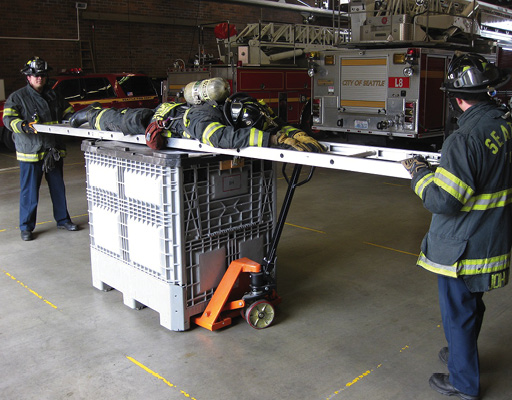
(4)

(5)
(1-5) The Roof Ladder Drag. A quick and easy way for two rapid intervention team (RIT) firefighters to drag and rescue an unconscious or injured firefighter is to use the roof ladder as a sled. Roof ladders are easier to use to drag the weight than shorter baby ladders. All the firefighter’s dead weight is supported by the ladder. There are no friction points except at the spurs, making it extremely easy to drag in what would otherwise be a taxing job for two firefighters. (Photos by author.) The roof ladder makes it extremely easy for two RIT firefighters to lift the down firefighter over an obstruction of almost any size and dimension. The tip of the roof ladder is brought to and rested on top of the obstacle. One firefighter can ensure that the tip doesn’t slide while the other firefighter lifts the ladder at the butt and pushes the ladder up on to the obstacle. Once the roof ladder has found balance, it can be spun 180° if room allows, or the evolution can continue with the firefighter in a head-first position. With the weight and friction of the body holding the down firefighter firmly in place between the beams, the roof ladder can be quickly and smoothly passed to the receiving firefighters on the opposite side of the obstacle.
Many buildings are vacant for a variety of reasons. Getting permission is often easy. The owner can actually feel “safer” knowing you’re familiarizing yourself and practicing in his building, preparing for an emergency that may happen. The owner may not have a problem with the fire department practicing on the structure if it includes throwing ladders and laying dry (or even wet) hose, as long as it doesn’t result in property damage.
Wet hose doesn’t mean flowing water; that is not where we are getting jammed up. Many errors and problems occur in setting up the exterior fireground, laying hose in stairwells, and advancing charged hoselines down and around hallways. Flowing water and working the nozzle are easier skills that you can practice outside. Class III standpipes are charged and connected to an automatic fire alarm system. You can run drills in these buildings by hooking up to the standpipe valve and running the evolution with dry hose without triggering the alarm.
Capturing Expertise
Fire Department of New York Deputy Chief (Ret.) Vincent Dunn used to say, “There’s no silver bullet” and “There’s nothing new under the sun,” meaning that there’s not just one way to do something and that, throughout the history of the fire service, every idea has been tried in one form or another. Fire has been around since the caveman days, and human dwellings have historically taken the shape of a box. So, in its simplest form, firefighting is applying water into a burning box.
Look at an aerial picture of any city—what do you see? Rows and stacks of boxes! There are only so many ways to get water into the box and smoke out of a box. How many ways can you rescue a person out of a box? Occupants are either protected in place or exit the box through doors, windows, stairs, down ladders, or airlifted off roofs; it’s not rocket science. We often make it harder than it needs to be. We need to think smarter, not work harder.
Most “boxes” (buildings) in every American city are still 20th-century structures. The old strategy-and-tactics books are still extremely relevant because the buildings to which they refer are still standing! Therefore, if you want to know how the “old guys” used to fight fire, read the old books. To truly comprehend modern firefighting, a student of fire should have knowledge of the old tactics to understand how they have evolved over the years. The problem is, many of these texts, which are more than 50 years old, are out of print. So, the information is not readily accessible to new firefighters. You must hunt for it, but it’s still there.
For example, let’s take a senior crew of four firefighters, each with 30 years on the job. If they all retired at once, that’s 120 years of experience walking out the door. Unless you capture it, it’s gone. Senior members know the “tricks of the trade.” They’ve been exposed to the many ways we can apply water on the burning boxes and the ways to get the smoke and people out of the box. Often, the reason they have never passed on this information is because no one ever bothered to ask.
So, does practice make perfect? Practice only makes perfect when that which is practiced is correct. A procedure done wrong will never become right simply because it’s practiced. Perfection doesn’t consist of doing extraordinary things but in doing ordinary things extraordinarily well. And, you can’t engineer your way out of bad behavior, either. The time to correct errors is during the drill. It is practically impossible to correct mistakes on the fireground. Fewer errors occur on the fireground if we have spent the time drilling for it.
Dreading the Company Drill
All fire departments have very good entry-level training programs, but very few have excellent officer development courses. After the promotional process, many company officers are “self-taught” and learn how to be an officer by trial and error. Although the “School of Hard Knocks” is invaluable experience, it also wastes a lot of time, sometimes even years! Officers can also learn bad habits or erroneous teaching methods that were passed on to them.
What type of atmosphere do you want to create for a company drill? Is it conducive to learning, or is it dreaded? If your crew dreads drilling, let’s look at some potential reasons. They may be afraid of the following:
- Looking stupid in front of their peers.
- Being exposed for their deficiencies.
- Getting teased.
- Looking bad in front of the chief.
- Officers who show off their knowledge at the crew’s expense.
- Laziness.
Do you enjoy making your crew look stupid? No one is going to admit this, but it’s all about perception. If your crew perceives that you enjoy making them look stupid, especially in front of the battalion chief, then that’s how it is. Some officers like to “show off” (especially in front of the chief). They use a drill as an opportunity to demonstrate how smart they are at the crew’s expense. These are huge negatives as well as obstacles for getting to the next level of expertise.
Firefighters also fear exposure, such as being exposed for the knowledge they should but don’t have or from actual ignorance of the subject matter. Firefighters don’t like to look stupid in front of their peers. And, when it comes to performance, they hate to be teased. It’s all about saving face. Everyone should view training and company drills as an opportunity to learn something new and a chance to raise their level of expertise. Who doesn’t want to be good at what they do? So, this should be a positive activity. That’s why drilling should not be punitive or used as a form of discipline; this associates it with something negative.
Hazing is a form of teasing and is prohibited in many fire departments, so keep that association away from drilling and training as well. Use common sense. If engine or ladder evolutions were performed “unsatisfactory” during the annual company evaluations with the battalion chief, go back and practice those evolutions until you make the required times without errors. That is a good type of discipline, not punitive discipline. Help your crew understand the difference. For example, if an engine company screws up charging a standpipe and advancing an attack line to the fifth floor—on either an actual incident or at a battalion evaluation—take that company out and run that evolution over and over again until they get it right; this is a reasonable expectation. However, if that same company were out of uniform and playing ping pong at 0900 hours when the chief suddenly drops by the station, don’t take them out and run 10 standpipe evolutions. That situation reflects more poorly on the company officer’s leadership style and organizational skills than it does on the crew.
Then, of course, there are crews who are just plain lazy; again, this reflects more poorly on the officer’s style of leadership and organizational skills than on the crew. Take proactive measures to control the environment so these things don’t happen. Never use drilling as a form of hazing, punishment, or discipline. Company officers need to set performance expectations with their crews right from the start.
The Buddy-to-Boss Syndrome
There is much written on this subject. It’s natural to want to be liked by others, but if you are a supervisor, they already don’t like you (in a friendly way). The “buddy-to-boss” syndrome boils down to this: You used to be one of the guys, maybe even the informal leader. The camaraderie was strong and seemed invincible. But now you’ve been promoted; you are no longer one of the guys because you now have the hammer, and they’re still the “nails” (trust me, they already know this). The only one having trouble figuring this out is you!
Remember, you are going to be held accountable for the performance of your crew. When something serious happens and you get called onto the carpet in front of the chief, you’ll be cured. When you get back to the station, you’ll figure out which one you’re supposed to be: a buddy or a boss.
From Basics to Advanced
How do you rachet up the skill level from basic to intermediate to advanced? Basic skills don’t become moderate to advanced by adding new steps and procedures; they do so by applying basic skills to unique scenarios and unusual situations. One way to complicate drills is simply by performing them at night or in the dark. For example, every rope rescue class I have attended occurred on a nice, sunny day. However, I often drilled my crews at night. The same evolution becomes more complicated when the only illumination is from your helmet light.
In another example, my ladder company experimented with numerous portable lighting techniques in a large acquired structure. A portable lighting drill is not an exciting topic for ladder companies, but it is one of the important services with which we will be tasked. I posed the question: “How do we light up a room with string lights when all the walls are smooth concrete?” We figured out a way to make tripods and a horizontal light bar using pike poles and baby ladders. It was creative, but the drill became more challenging when I surprised the company and returned to the building at night to perform those same evolutions. Since the building was abandoned, the power had been cut by the city, so we had to run a power cord from the apparatus generator to light up one location and bring up the portable generator to set up all the portable lighting in another location—all in the dark for a more realistic situation.
We did the same thing with a rescue air kit (RAK). The RAK is a portable self-contained breathing apparatus (SCBA) unit carried in a bag as part of the rapid intervention team’s (RIT’s) required equipment. Most RAK drills are simulated; performed on a rescue mannequin; and conducted in daylight, often in the apparatus bay. Again, it’s not realistic. Conduct this evolution, at minimum, in the dark on a real firefighter. Sometimes, my crew conducted this drill after dinner in the basement of the firehouse when everything was pitch black—a totally different evolution regarding speed and efficiency, not an easy task!
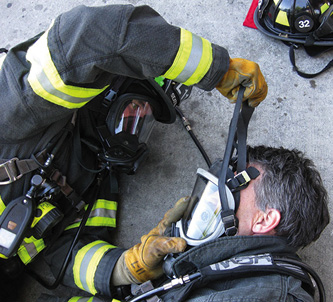
(6)
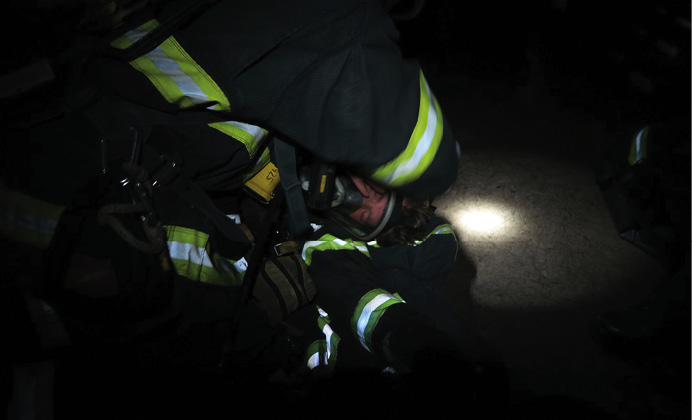
(7)
(6-7) The Rescue Air Kit (RAK). RIT drills should include the quick and proper application of the RAK including the donning of a self-contained breathing apparatus (SCBA) face piece on a real firefighter, not on a mannequin. The procedure should not be simulated; it is not realistic. Zero visibility with the only illumination coming from the light on your helmet is realistic. Simply performing this evolution in total darkness changes a pretty straightforward procedure into a challenging and frustrating evolution if it hasn’t been practiced. This is something the RIT must get right 100 percent of the time. What good is it to rescue a down firefighter only to have him die because he ran out of air or the RAK and the face piece were applied incorrectly?
I often hear company officers state how they aim to get all their work and drills out of the way by dinnertime and leave the evening free for the crew to relax. That may be the nice thing to do, but is it the best way? All of our emergency calls don’t come in before dinner; in fact, many come in at night—in the dark!
How are we supposed to become good at night operations when we never practice at night? Don’t worry about being nice; “nice” doesn’t garner respect the same way that drilling your crews in realistic and unusual situations does. When you do everything you can to prepare them for battle and success, you will earn their respect. Remember, the harder the drill, the more they brag about it. However, use common sense; keep it realistic and safe, not out of this world. As far as time to relax, aren’t those called “days off”?
So, What Do We Drill On?
Drills you’re not going to find in the books are drills that are based on circumstances or contributing factors that led to a LODD, which gives them relevance and credibility. If you want to identify training needs or deficiencies for fireground operations, open any National Institute for Occupational Safety and Health LODD report. Read case studies on major fires involving firefighter injuries and deaths. Read the firefighter close-call Web sites and study Internet videos. These sources are indicators pointing to the causes that are getting our firefighters injured or killed. They are also gauges tracking behavioral trends and consequences within the fire service.
For example, consider a firefighter who falls through the first floor into a burning basement. Provided the firefighter is not injured, are we teaching ways a firefighter can self-extricate from a basement? I run a drill called “The Wall,” which teaches numerous ways a firefighter can climb up a seven-foot wall to a window using a variety of single tools such as a halligan, a pike pole, a section of hose, an ax, or a carabiner with webbing. These techniques can be single-firefighter skills or used in conjunction with a partner.
In the same scenario, how can a single firefighter assist in the basement rescue from the exterior? By placing a roof ladder down into the window of the basement. If there isn’t a window, how quick can the firefighter make one?
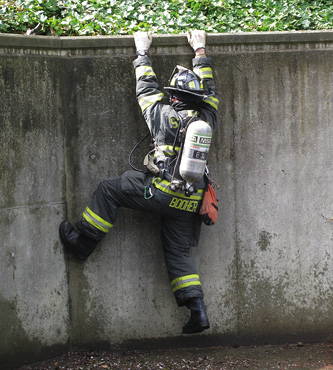
(8)

(9)
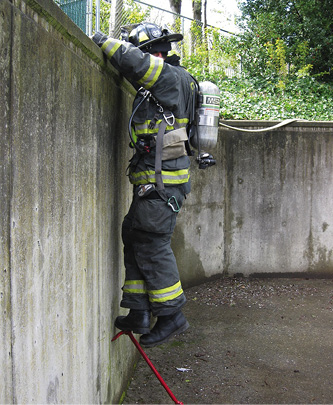
(10)
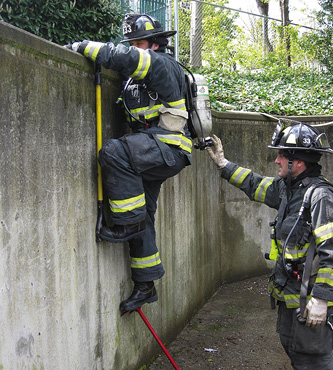
(11)
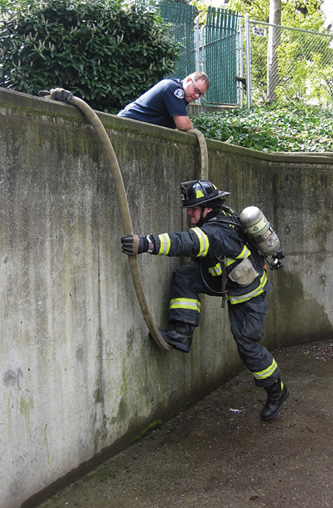
(12)
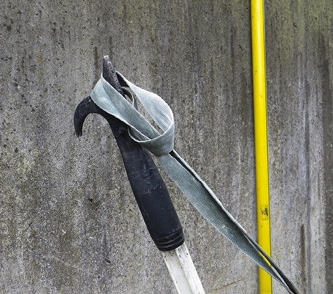
(13)

(14)

(15)
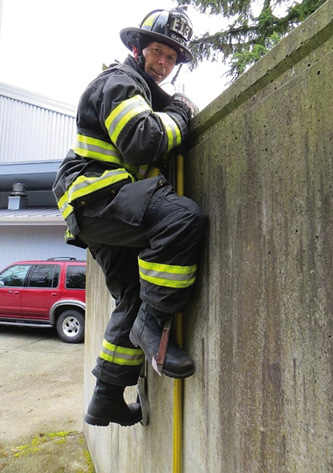
(16)
(8-16) The Wall. A firefighter must pull himself up a seven-foot wall. It is impossible for even the fittest firefighter in full personal protective equipment, including SCBA. Firefighters without tools must work together to help each other over the wall. The firefighter uses a single tool to get over the wall and then uses a halligan bar and a D-handle pike pole to create a ladder to scale the wall. A charged hoseline is then lowered to create a horseshoe sling to assist the firefighter over the wall. The spike makes a perfect hand grip or can be used to loop a piece of webbing. The hook and spike of the pike pole can also be an effective anchor and purchase when placed on a horizontal ledge of concrete without slipping. The D-handles serve as stirrups, and using the webbing or body loop creates a three-step ladder. This three-step ladder makes for an easy ascent over the wall for even the heaviest firefighter.
Drill Tips to Make Things Challenging
Firefighters love to be challenged, especially on realistic drills. If you can cite a firefighter close-call incident, it gives your drill credibility. For example, I took years of grief and ridicule for extending the tip of an aerial ladder with a roof ladder during a drill. Some chiefs and peers criticized me for being reckless and unsafe. I posed the question to my deputy chief, how would he prefer we make a window rescue when it was beyond the reach of the aerial ladder? I convinced him that my unorthodox method would work; it was better than reporting the victim had jumped because we ran out of aerial ladder.
When I joined the fire department in the 1970s, we still carried pompier ladders to make a window rescue from the floor below when the fire was above the reach of aerial ladders. These ladders were removed from service around 1980 because they were deemed “unsafe.” However, alternative methods were never taught. Well, with the weight-carrying requirements and strengths of roof ladders, this is the alternative method. Securely lashing a roof ladder to the rungs of a fully extended aerial can give you an extra 10 feet of reach at the tip—not for the firefighter to climb out on but for a victim on a ledge to climb on. Another method is to raise a roof ladder from the window below the objective in the same manner as the pompier ladder was used to effect rescue of a victim on a ledge.
On January 29, 2020, this exact scenario played out at the Barrington Plaza Fire in Los Angeles, California. The fire started on the seventh floor of a 26-story nonsprinklered residential high-rise. The intense fire, fueled by 35 mile-per-hour winds, forced an occupant onto the ledge of Floor 7. There wasn’t even a ledge; the victim was holding on by his toes and fingertips. The aerial ladder was fully extended and just short of the victim. The victim gingerly inched his way to get closer to the tip, and this dramatic rescue was captured on hundreds of cell phone videos. The victim’s ability to maneuver made his rescue possible. However, had firefighters extended the reach of the aerial with the roof ladder carried on the aerial, the rescue could have been made more quickly with a greater margin of safety for the victim. Placing the roof ladder to the victim from Floor 6 would have also worked like a straight ladder fire escape.
In a post-9/11 world, there are no more “normal” emergencies. Anything imaginable can happen, and it’s not always going to be in a major metropolitan city; it can be in your town with limited resources. The bottom line is, you can’t hesitate and wonder how New York, Los Angeles, or Seattle firefighters would handle an incident. The public isn’t going to call for the Navy SEALS or the Marines. They’re going to call you—their local fire department. You must make the decisions. Whatever actions you take, you’re the expert on scene. It’s YOUR call.
RAUL A. ANGULO retired from the Seattle (WA) Fire Department with more than 37 years of service and was captain of Ladder 6. He is a contributing author to Fire Engineering and an advisory board member of Fire Apparatus & Emergency Equipment. He has taught at FDIC International since 1996 and is the author of Engine Company Fireground Operations, 4th Edition.

